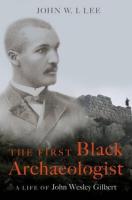
OUP (2022) h/b 418pp £30 (ISBN 9780197578995)
L. is an Associate Professor in the History department of the University of California Santa Barbara. This book, his second monograph, is a biography of John Wesley Gilbert, the man who he has established was the first African American to take part in an archaeological investigation outside the United States.
It is perhaps a bit strong to call Gilbert an archaeologist. He spent nine months in Europe as a student at the American School of Classical Studies in Athens and participated only in a single two month dig, at Eretria on the island of Euboea. On his return to America he did not participate in any further archaeological activity. He was, however, a serious investigator on the Eritrea dig, using the knowledge of surveying that he had acquired on an undergraduate elective course to map the topography of the site with care and precision. He was certainly more professional than his boss who was only interested in uncovering jewellery or statuary and who proceeded to identify, with minimal credibility, a site as the tomb of Aristotle’s daughter.
Gilbert was undoubtedly a remarkable man. He was born in 1863 in Georgia to a slave mother on a slave estate in the middle of the Civil War. He never knew his father and was taken by his mother to live in nearby Augusta when she was emancipated. She remarried in 1870, but Gilbert never took his stepfather’s name. His mother ensured that he attended schools for coloured children in Augusta, financed successively by Methodists and Baptists. Despite opposition to the education of blacks beyond intermediate grades, he managed to gain entry to Paine Institute, which uniquely in Georgia was run by a joint white/black board of Trustees, and offered a wide ranging course which included Latin, Greek and French.
Aspiring later to go on to graduate studies, he applied for a place a thousand miles away at Brown University in Rhode Island, where he was the only black student in his year group (1886/88). After graduating at Brown he returned to Paine Institute as Professor of Greek. He remained at Paine for the rest of his career, except for his journey to Athens in 1890/91 and a visit to the Congo in 1911/12 to explore the possibility of establishing a Methodist Mission there. Much of his subsequent career involved fund raising for Paine Institute which was always chronically strapped for cash. He and his wife were both badly injured in a car crash in 1919 from which they never recovered, dying respectively in 1922 and 1923.
This story is exhaustively researched by L. There are innumerable mini-biographies of the many associates and colleagues with whom Gilbert shared his journey. Given the timing, many of them, like Gilbert, were the first African Americans to acquire entry to academic institutions post emancipation or to rise to positions of significance particularly in the fields of ministry or teaching. Many others were white Americans who campaigned resolutely for desegregation alongside their black colleagues. L.’s list of personal acknowledgements runs to at least 200 individuals, and there are in addition 120 pages of notes and bibliography. The background activities of the various churches and charitable organisations that contributed so assiduously to the educational development of the emancipated community are fully described, as is the persistent, and occasionally violent, resistance to that development by the white community in the South. Only the reproduction of many of the 30-odd illustrations leaves something to be desired.
The saddest issue is that, despite L.’s comprehensive depiction of the context in which he worked, because (mainly) of to the depredations of fire and flood, little has survived of the personal voice of the man himself. Such clues as do exist suggest a reserved, but quietly determined man. He seems to have paid little attention to his mother after his teenage years, and he regularly put the demands of his professional life ahead of those of his immediate family. Pressed to choose between ministry and teaching he almost always chose teaching. He experienced politeness rather than warmth from his university colleagues and occasional disdain from his European contacts, but never apparently allowed any resentment to show. Indeed while he was fundraising he had occasionally to compromise with his desegregation principles. His aptitude for languages was prodigious. Apart from his classical Latin and Greek, he could communicate readily in Biblical Hebrew, wrote fluent French, studied Zulu and, through that, mastered two Congolese languages. During his visit to the Congo he translated the epistles 1 Corinthians and Romans into Otetela, the language of the Batetela, a tribe with which he clearly developed a warm empathy. He was generally regarded as an excellent communicator, teacher and administrator.
One has huge admiration for a life full of challenges quietly surmounted. Of interest to CfA readers will be perhaps the syllabus of classical studies in 1870 Georgia. The study of Latin began with translating Caesar’s Gallic wars and at university, Horace, Terence and Juvenal. For Greek it was the New Testament first, followed by Euripides’ Alcestis, Demosthenes de corona and Plato’s Crito. Homer and the Homeric question were introduced at postgraduate level. There is no mention at any level of translation from English into either language. For a masters’ degree a dissertation was required, and Gilbert chose ‘The Urban Demes of Attica’. Unfortunately only a month or so after he had produced his paper (which was probably mainly about their geographical identification) the text of the Athenaion Politeia was published which revolutionised the topic and diminished the reception of his paper. The study of archaeology in the United States was launched in 1888 by the delivery of several plaster casts of classical Greek sculptures.
Roger Barnes
